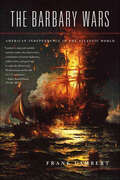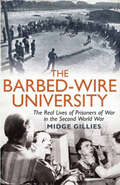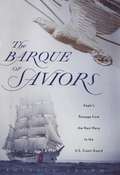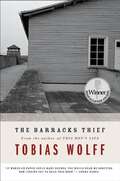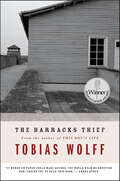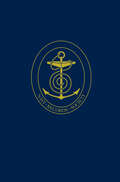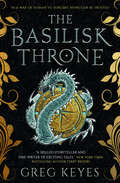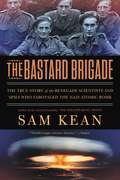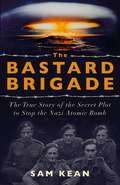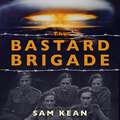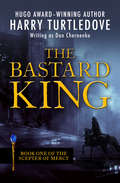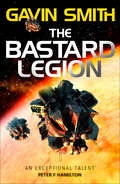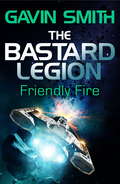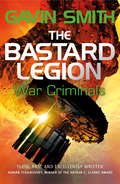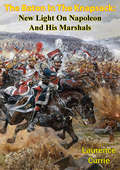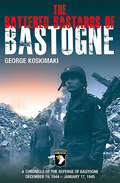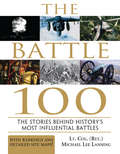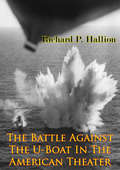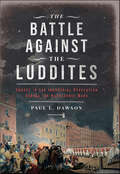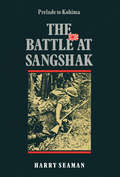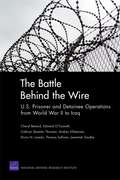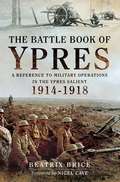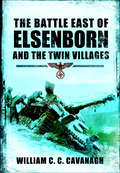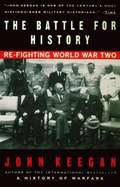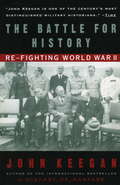- Table View
- List View
The Barbary Wars: American Independence in the Atlantic World
by Frank LambertThe history of America's conflict with the piratical states of the Mediterranean runs through the presidencies of Washington, Adams, Jefferson, and Madison; the adoption of the Constitution; the Quasi-War with France and the War of 1812; the construction of a full-time professional navy; and, most important, the nation's haltering steps toward commercial independence. Frank Lambert's genius is to see in the Barbary Wars the ideal means of capturing the new nation's shaky emergence in the complex context of the Atlantic world.Depicting a time when Britain ruled the seas and France most of Europe, The Barbary Wars proves America's earliest conflict with the Arabic world was always a struggle for economic advantage rather than any clash of cultures or religions.
The Barbed-Wire University: The Real Lives of Prisoners of War in the Second World War
by Midge Gillies“A moving and eye-opening account of the lives of second world war PoWs by the daughter of a man who was captured . . . a riveting collection of stories.” —The GuardianFeature films like The Bridge on the River Kwai and The Great Escape have created the stereotype of the Second World War prisoner of war. But, as Midge Gillies shows in this groundbreaking work of social history, the true experiences of nearly half a million Allied servicemen held captive during the Second World War were nothing like the Hollywood myth—and infinitely more extraordinary.The real lives of POWs saw them respond to the tedium of a German stalag or the brutality of a Japanese camp with the most amazing ingenuity and creativity. They staged glittering shows, concerts and elaborate sporting fixtures, made exquisite ornaments—even, amid the terrible privations of the Thailand-Burma railway, improvised daring surgical techniques to save their fellow men’s lives. Whatever skills or hobbies they took with them to captivity they managed to continue and adapt—to the extent of laying out a 9-hole golf course between the huts of one German camp. They took up crafts and pastimes using materials they found around them: even the string from a Red Cross food parcel was used to make cricket balls, football nets and wigs for theatrical performances. Men studied, attended lectures, learned languages, sat for qualifications and exams, on such a scale that one camp was nicknamed “The Barbed-Wire University.”Drawing on letters home, diaries and interviews with redoubtable survivors now into their nineties, Midge Gillies recreates the daily lives of a truly remarkable group of men. “Astonishing tales of improvisation, ingenuity and courage.” —The Spectator
The Barque of Saviors: Eagle's Passage from the Nazi Navy to the U.S. Coast Guard
by Russell DrummThe &“remarkable story&” of a tall ship&’s history in WWII and beyond—and the sailors who have inhabited it, both German and American (Booklist). Hamburg, 1936: A splendid three-masted sailing ship is christened Horst Wessel in the presence of Adolf Hitler and thousands of cheering Nazis. It would become a training vessel for naval officers during World War II—but after Germany&’s defeat, the US Coast Guard found its young crew terrified and half starved. The Coast Guardsmen brought the Germans, so recently their mortal enemies, back to life; the Germans, in return, taught them the ways of the beautiful square-rigged ship, rechristened Eagle. In time, Eagle would become the Coast Guard&’s elite school ship—the barque of saviors. Uncannily linking Eagle&’s malign past and its American present is a coast guardsman named Karl Dillmann, who believes the spirit of a young German sailor drowned in a U-boat explosion inhabits his soul. The voices of Dillmann and other crew members are heard throughout the book, as are the voices of young sailors on the Horst Wessel. Russell Drumm has obtained never-before-published logbooks from its war years, affording fascinating new insights into both the ship&’s everyday life and its moments of high drama. This unique piece of maritime history captures the feeling of life at sea, and shows how the courage and sacrifice of the &“greatest generation&” are alive and well today in the dedicated members of the US Coast Guard. &“Tall ships cast spells, and Drumm catches the witchery of the Eagle&’s overpowering presence.&” —Kirkus Reviews &“The reader becomes familiar with the cadets of various eras . . . The book also offers a rare look at postwar military cooperation and at the integration of female cadets beginning in the 1970s.&” —Publishers Weekly
The Barracks Thief
by Tobias Wolff"The Barracks Thief" is the story of three young paratroopers waiting to be shipped out to Vietnam. Brought together one sweltering afternoon to stand guard over an ammunition dump threatened by a forest fire, they discover in each other an unexpected capacity for recklessness and violence. Far from being alarmed by this discovery, they are exhilarated by it; they emerge from their common danger full of confidence in their own manhood and in the bond of friendship they have formed. This confidence is shaken when a series of thefts occur. The author embraces the perspectives of both the betrayer and the betrayed, forcing us to participate in lives that we might otherwise condemn, and to recognize the kinship of those lives to our own.
The Barracks Thief
by Tobias WolffThe Barracks Thief is the story of three young paratroopers waiting to be shipped out to Vietnam. Brought together one sweltering afternoon to stand guard over an ammunition dump threatened by a forest fire, they discover in each other an unexpected capacity for recklessness and violence. Far from being alarmed by this discovery, they are exhilarated by it; they emerge from their common danger full of confidence in their own manhood and in the bond of friendship they have formed.This confidence is shaken when a series of thefts occur. The author embraces the perspectives of both the betrayer and the betrayed, forcing us to participate in lives that we might otherwise condemn, and to recognize the kinship of those lives to our own.
The Barrington Papers: Vol. I
by D. Bonner-SmithSamuel Barrington (1729-1800), a son of the first Viscount Barrington, entered the Royal Navy in 1740. He was posted in 1747 and eventually was promoted to Admiral in 1787.Papers in the possession of Barrington’s collateral descendants form these two volumes and cover his naval career. They comprise order books (1747-71), a private letter book (1770-99), his journal and three bound documents relating to the Leeward Islands command (1778-79), some loose correspondence, and printed matter: the general sailing and fighting Instructions, two signal books, and instructions. None of Barrington’s public letter books survives.This includes Barrington’s negotiations at Tetuan to release British subjects held by the Barbary corsairs, and his cruising off the coast of Guinea where some Royal Navy captains had been personally profiting from commercial dealings including the transportation of slaves.Commanding the 60-gun Achilles, he served from 1757-59 off the coast of France, in 1760 under Captain the Hon John Byron destroying the fortifications of Louisbourg in North America, and in 1761 under Commodore Augustus Keppel in the operations against Belle-Île. From 1762 until the 1763 Treaty of Paris, he commanded the 74-gun Hero. From 1768, when he again took to sea, until 1778 when he received his flag, he saw service in the dispute with Spain over the Falkland Islands (1771) and in the Channel.
The Basilisk Throne
by Greg KeyesMaster and Commander meets A Game of Thrones and Pirates of the Carribean. Rapid-paced high fantasy with all-out combat on the high seas, and a canny young woman who faces the hidden threats of an imperial court. Yet the key to defeating a sorcerous enemy may lie with a wild rogue and the slave of a maniac.For centuries the Drehhu have ruled every continent, brutally enslaving the human inhabitants. Now after endless wars the human empires of Ophion, Velesa, and Modjal have pushed the inhuman enemy back to their heartland and unite in a final, massive assault.Alastor Nevelon and his son Crespin set sail against the Drehhu, and they have their own secret weapons. Yet Alastor is forced to send his daughter Chrysanthe to the capitol city Ophion Magne as a &“token&” of his loyalty to the emperor. He instructs Chrysanthe to use her considerable intellect to discover what plots may be afoot, even as she enters a place where courtly manners hide murderous intent.As nations collide the true key to defeating the Drehhu may lie in a remote mountain stronghold, with a wild rogue known as Hound and Ammolite, the young slave of a sorcerer more ancient than any nation—whose loyalties remain threateningly unknown.
The Bastard Brigade: The True Story of the Renegade Scientists and Spies Who Sabotaged the Nazi Atomic Bomb
by Sam KeanFrom New York Times bestselling author Sam Kean comes the gripping, untold story of a renegade group of scientists and spies determined to keep Adolf Hitler from obtaining the ultimate prize: a nuclear bombScientists have always kept secrets. But rarely have the secrets been as vital as they were during World War II. In the middle of building an atomic bomb, the leaders of the Manhattan Project were alarmed to learn that Nazi Germany was far outpacing the Allies in nuclear weapons research. Hitler, with just a few pounds of uranium, would have the capability to reverse the entire D-Day operation and conquer Europe. So they assembled a rough and motley crew of geniuses - dubbed the Alsos Mission - and sent them careening into Axis territory to spy on, sabotage, and even assassinate members of Nazi Germany's feared Uranium Club. The details of the mission rival the finest spy thriller, but what makes this story sing is the incredible cast of characters-both heroes and rogues alike-including: Moe Berg the major league catcher who abandoned the game for a career as a multilingual international spy; the strangest fellow to ever play professional baseball.Werner Heisenberg the Nobel Prize-winning physicist credited as the discoverer of quantum mechanics; a key contributor to the Nazi's atomic bomb project and the primary target of the Alsos mission. Colonel Boris Pash a high school science teacher and veteran of the Russian Revolution who fled the Sovit Union with a deep disdain for Communists and who later led the Alsos mission. Joe Kennedy Jr. the charismatic, thrill-seeking older brother of JFK whose need for adventure led him to volunteer for the most dangerous missions the Navy had to offer. Samuel Goudsmit a washed-up physics prodigy who spent his life huntinh Nazi scientist-and his parents, who had been swept into a concentration camp-across the globe. Irène and Frederic Joliot-Curie a physics Nobel-Prize winning power couple who used their unassuming status as scientists to become active members of the resistance. Thrust into the dark world of international espionage, these scientists and soldiers played a vital and largely untold role in turning back one of the darkest tides in human history.
The Bastard Brigade: The True Story of the Renegade Scientists and Spies Who Sabotaged the Nazi Atomic Bomb
by Sam KeanScientists have always kept secrets. But rarely in history have scientific secrets been as vital as they were during World War II. In the midst of planning the Manhattan Project, the U.S. Office of Strategic Services created a secret offshoot - the Alsos Mission - meant to gather intelligence on and sabotage if necessary, scientific research by the Axis powers. What resulted was a plot worthy of the finest thriller, full of spies, sabotage, and murder. At its heart was the 'Lightning A' team, a group of intrepid soldiers, scientists, and spies - and even a famed baseball player - who were given almost free rein to get themselves embedded within the German scientific community to stop the most terrifying threat of the war: Hitler acquiring an atomic bomb of his very own.While the Manhattan Project and other feats of scientific genius continue to inspire us today, few people know about the international intrigue and double-dealing that accompanied those breakthroughs. Bastard Brigade recounts this forgotten history, fusing a non-fiction spy thriller with some of the most incredible scientific ventures of all time.
The Bastard Brigade: The True Story of the Renegade Scientists and Spies Who Sabotaged the Nazi Atomic Bomb
by Sam KeanNew York Times bestselling author Sam Kean tells the incredible story of how a renegade group of spies kept Hitler from obtaining his ultimate prize: a nuclear bomb.Scientists have always kept secrets. But rarely in history have scientific secrets been as vital as they were during World War II. In the midst of planning the Manhattan Project, the U.S. Office of Strategic Services created a secret offshoot - the Alsos Mission - meant to gather intelligence on and sabotage if necessary, scientific research by the Axis powers. What resulted was a plot worthy of the finest thriller, full of spies, sabotage, and murder. At its heart was the 'Lightning A' team, a group of intrepid soldiers, scientists, and spies - and even a famed baseball player - who were given almost free rein to get themselves embedded within the German scientific community to stop the most terrifying threat of the war: Hitler acquiring an atomic bomb of his very own.While the Manhattan Project and other feats of scientific genius continue to inspire us today, few people know about the international intrigue and double-dealing that accompanied those breakthroughs. Bastard Brigaderecounts this forgotten history, fusing a non-fiction spy thriller with some of the most incredible scientific ventures of all time.(P) 2019 Hachette Book Group Audio Ltd
The Bastard King (The Scepter of Mercy #1)
by Harry TurtledoveTwo rivals must unite to prevent a disgraced malevolent god from attaining a relic of extraordinary power in the first book of alternate history master Harry Turtledove's magnificent fantasy trilogy More than four centuries ago, the Scepter of Mercy was lost to the king of Avornis, and each subsequent liege has promised--and failed--to return the powerful talisman to its rightful home. Now, young Lanius, the only surviving son of King Mergus, rules, though he is considered illegitimate and must abide by the decisions of regents. Still, the legacy of the missing scepter ultimately belongs to him. But it is also coveted by the Banished One, an immortal exiled by the other gods, who invades the world of men through their dreams. Lanius, with no talent or heart for battle, must keep those in the sway of the malevolent deity from Avornis's borders. To this end, Lanius requires the help of Grus, a fearless and respected captain of the king's navy. But Grus has a far loftier destiny than his common birth would suggest--and the bastard king's brave, accomplished ally might well turn out to be his most dangerous adversary. Originally published under the pen name Dan Chernenko, The Bastard King is a magnificent foray into epic fantasy by the incomparable Harry Turtledove, the prolific and multi-award-winning master of alternate history science fiction. A tale of courage and destiny, it is alive with action, imagination, and humanity, and populated by richly complex, imperfect heroes and a villain as truly fiendish as any that has ever graced the fantasy genre.
The Bastard Legion: Book 1 (The Bastard Legion)
by Gavin G. Smith'High octane SF adventure with Smith's trademark twist' Jamie Sawyer'An exceptional talent' Peter F HamiltonFour hundred years in the future, the most dangerous criminals are kept in suspended animation aboard prison ships and "rehabilitated" in a shared virtual reality environment. But Miska Corbin, a thief and hacker with a background in black ops, has stolen one of these ships, the Hangman's Daughter, and made it her own. Controlled by explosive collars and trained in virtual reality by the electronic ghost of a dead marine sergeant, the thieves, gangsters, murderers, and worse are transformed into Miska's own private indentured army: the Bastard Legion. Are the mercenaries just for fun and profit, or does Miska have a hidden purpose connected to her covert past?'Gloriously action-packed and often brutal military SF adventure . . . This series launch will keep readers turning pages, eager to see what bloody adventure awaits and how the legion develops into a force to be reckoned with' Publishers Weekly STARRED REVIEW
The Bastard Legion: Book 2
by Gavin G. Smith'High octane SF adventure with Smith's trademark twist' Jamie Sawyer, author of The Lazarus War'An exceptional talent' Peter F HamiltonIn FRIENDLY FIRE, the Bastard Legion are hired to pull off a daring power-armoured heist of propriety tech. A crime-ridden colony world holds the secret to a potential alien contact, and various groups of mercenaries have been hired to discover it. None of the rest of them have little bombs implanted in their heads, though, so the Bastards have an advantage when it comes to motivation. And Miska, their commander and kidnapper both, is still on the hunt for the people who killed her father. People who might still be among her convicts.Getting the tech will be hard. Getting off the planet, deadly.'a brutal kaleidoscope of imagination' Hannu Rajaniemi, author of The Quantum Thief
The Bastard Legion: Book 3 (The\bastard Legion Ser.)
by Gavin G. SmithDirty, gritty and action-packed adventure featuring the galaxy's deadliest mercenaries, THE BASTARD LEGIONMILITARY SCIENCE FICTION AT ITS BEST. 'High octane SF adventure with Smith's trademark twist' Jamie Sawyer, author of The Lazarus War It was the kind of dirty, violent work the Bastards were made for. Protect a bunch of colonists in the Epsilon Eridani system, whose moon had become a war zone as megacorp-backed mercenaries fought a brutal proxy war. Just the kind of fight the penal mercenary legion liked. But a hundred headless corpses are hard to explain, even for the Bastard Legion, and soon they are on the run, abandoned by their allies, and hunted by their most dangerous foe yet . . . but Miska's going to play them at her own game. The Bastard Legion: the galaxy's most dangerous criminals controlled by implanted explosives and trained by the electronic ghost of a dead marine. 'Gloriously action-packed and often brutal military SF adventure . . .' Publishers Weekly 'An exceptional talent' Peter F HamiltonA 'Dirty Dozen' or 'Suicide Squad' for lovers of 'Aliens', THE BASTARD LEGION series is a down and dirty military SF set in a world of mercenary actions and covert operations.
The Baton In The Knapsack: New Light On Napoleon And His Marshals
by Laurence CurrieTHE purpose of this book is to sketch briefly the career of Napoleon, especially his relations with his marshals, and to consider how far the marshals were responsible for the rise of the Napoleonic Empire and how some of them at any rate contributed to its fall.It was a saying among the rank and file of the armies of revolutionary France that every soldier carried in his knapsack the bâton of a marshal. This was to prove truer than is usual with such dicta; for more than half of Napoleon's marshals did actually arise from the ranks.In reviewing the period, the student of history can hardly fail to be fascinated by the deeds of valour casting a halo of romance over the entire epoch and to feel that wars productive of so many heroes can hardly have been fought in vain.Mechanical inventions have since degraded the art of war, robbed it of all glamour and added greatly to its horrors. Cavalry charges, such as those which proved decisive at Marengo and at Friedland, are now impossible; but, so long as mankind takes any interest in the past, the story of these mighty contests will always stir the imagination and perhaps excite the envy of future generations.
The Battered Bastards of Bastogne: A Chronicle of the Defense of Bastogne December 19, 1944–January 17, 1945
by George Koskimaki&“Fleshes out in vivid detail the entire story of the Screaming Eagles&’ valiant struggle . . . This is must reading for any student of World War II history&” (Kepler&’s Military History).The Battered Bastards of Bastogne is the product of contributions by 530 soldiers who were on the ground or in the air over Bastogne. They lived and made this history, and much of it is told in their own words. The material contributed by these men of the 101st Airborne Division, the Armor, Tank Destroyer, Army Air Force , and others is tailored meticulously by the author and placed on the historical framework known to most students of the Battle of the Bulge. Pieces of a nearly 60-year-old jigsaw puzzle come together in this book, when memoirs from one soldier fit with those of another unit or group pursuing the battle from another nearby piece of terrain.
The Battle 100
by Michael Lee LanningA single day in the heat of armed conflict can shape the future of the world. Throughout history, individual battles have inspired the birth of nations, the devastation of cultures and the triumph of revolutions. Yet while some battles rise up as the cornerstones of history, others fade in our cultural memory, forgotten as minor skirmishes. Why is this so? What makes a battle "important"?Celebrated veteran and military expert Michael Lee Lanning offers a provocative response with The Battle 100: The Stories Behind History's Most Influential Battles. Lanning ranks history's 100 greatest battles according to their influence, both immediate and long-term. Thought-provoking and controversial, Lanning's rankings take us to the heart of the battles and reveal their true greatness.
The Battle Against The U-Boat In The American Theater [Illustrated Edition] (The U.S. Army Air Forces in World War II #6)
by Richard P. HallionIncludes 20 IllustrationsIn 1942 the Allied powers faced the most serious challenge to their control of the seas encountered in the Second World War: the menace of the U-boat. Fast, well- armed, and long-ranged, Hitler's submarines attacked shipping throughout the North Atlantic, often within sight of America's coastal towns and cities.Eventually, the combination of intelligence, land and sea- based air power, and surface vessel operations from both North American and British bases ended this threat, making possible the Allied build-up for the invasion of Europe in 1944.Flying radar-equipped long-range patrol planes, AAF airmen demonstrated the value of land-based air power against naval threats. This success has been reaffirmed consistently since the Second World War, from Vietnam and crises such as the Mayaguez incident to operations in Desert Shield and Desert Storm. The Harpoon-armed B-52s of our present-day global Air Force are the heirs of a sea-control tradition dating to the AAF's A-29s and B-24s of the Second World War.
The Battle Against the Luddites: Unrest in the Industrial Revolution During the Napoleonic Wars
by Paul L. DawsonAs the columns of French infantry marched up the slopes of the Mont St Jean at Waterloo, the British heavy cavalry, the Royal Scots Greys to the fore, crashed into the packed ranks of the enemy. This was not the first time the Greys had drawn their swords during the Napoleonic Wars – but it was their first against Napoleon’s troops. Three years earlier they had attacked workers in Halifax protesting at the introduction of machinery in the wool trade. Taking their name from Ned Ludd, who had smashed up knitting frames in Nottingham, the Luddites saw the emergence of mechanization as a threat to their livelihood, with machines replacing men. In response they took matters into their own hands by wrecking the new equipment. Industrial unrest had gathered pace throughout the 18th century and exploded in an unpresented wave of violence in 1799. Outbreaks of machine-breaking developed rapidly into strikes in a battle of capital against labor. A court battle ensued, culminating in new legislation in 1806 that backed the capitalists. This act, coupled with the impact of the Continental system introduced by Napoleon, which closed European and American ports to British merchants, heralded the largest economic depression of the era. Famine, pestilence and rising employment all fueled the fires of Luddism. Months of violence swept across the West Midlands, Lancashire and Yorkshire which saw one factory boss murdered; other factory owners began shooting protesting workers. The disturbances resulted in the mobilizing of thousands of regular soldiers – at one time there were as many British soldiers fighting the Luddites than there were fighting Napoleon on the Iberian Peninsula. As well as exploring these events, Paul L. Dawson also uncovers the origins of Luddism and their allies in the middle classes. The Napoleonic Wars marked the end of centuries old way of life in agriculture, textile production and the wider economy. The dramatic changes in Britain between 1790 and 1815 created a unique set of social grievances by those left behind by the unprecedented changes that were surging through the Britain which exploded into bitter fighting across large swathes of the country. With present day concerns over computerization replacing labor, this is a story that echoes down the centuries.
The Battle At Sangshak: Prelude to Kohima
by Harry SeamanThis book tells the story of a small, yet significant, battle that was a precursor to the better known battles for Imphal and Kohima.
The Battle Behind the Wire: U. S. Prisoner and Detainee Operations from World War II to Iraq
by Cheryl Benard Edward O'Connell Cathryn Quantic Thurston Andres Villamizar Elvira N. LoredoThis report finds parallels in U.S. prisoner and detainee operations in World War II, Korea, Vietnam, and Iraq: underestimation of the number to be held, hasty scrambling for resources, and inadequate doctrine and policy. Later, attempts to educate and influence prisoners and detainees are often made. The authors recommend that detailed doctrine should be in place prior to detention and that detainees should be interviewed when first detained.
The Battle Book of Ypres: A Reference to Military Operations in the Ypres Salient 1914–1918
by Beatrix BriceOf the many hard-fought battles on the Western Front, Ypres stands out as an example of almost inhuman endeavour. For four long years it was the focal point of desperate fighting. Officially there were four main battles in 1914, 1915, 1917 and 1918; these were more accurately peaks in a continuing struggle, for Ypres symbolised Belgian defiance, and the British continued to expend disproportionate resources on defending it. It never fell, although the Germans came close to its gates, and indeed its loss would have been a severe blow to morale.The Battle Book of Ypres, originally published in 1927 and now presented again as a special Centenary Edition, comprises a chronological account of the fighting in the Ypres Salient during the First World War, followed by a useful and unique alphabetical reference to the events in and around each hamlet, village or wood names familiar to those who fought or followed the course of war all those years ago, names now once again lost in insignificance. The names given to each stage of the struggle by the Battle Nomenclature Committee are listed in the appendix. Also included is an index of formations and units, an annotated bibliography and a new Foreword by military historian Nigel Cave.
The Battle East of Elsenborn and the Twin Villages
by William C. CavanaghA US Army historian chronicles a vital zone of conflict within The Battle of the Bulge in this authoritative and detailed account of WWII combat. With Allied forces encroaching on all fronts, Hitler made one final, desperate offensive in the Ardennes. While The Battle of the Bulge is extensively written about in histories of the Second World War, this book focuses on a critical but seldom explored aspect of the conflict: the five-day critical battle for the North shoulder of the Bulge at Rochearth-Krinkelt. The Bulge was fought was fought in many areas, but for the soldiers of the First Army—six of whom were awarded Congressional Medals of Honor for their brave acts during the engagement—it was won on this shoulder. Military historian William Cavanagh has studied official after-action reports, histories and unit reports of organizations involved in the battle. In addition, he has conducted an extensive program of individual contacts, not only with the US Army participants, local villages and resistance fighters, but also with German commanders at various levels in the three divisions involved. Having lived in the Ardennes for many years and served as a principle researcher for the Deputy Chief Historian for the United States Army, Cavanagh brings a rare insight and expertise to his subject.
The Battle For History: Re-fighting World War II
by John KeeganA fascinating guide to the history and historiography surrounding the Second World War.
The Battle For History: Re-fighting World War II
by John KeeganWith the same erudition, discernment, and crisp prose that made his A History of Warfare an international bestseller, Keegan surveys the literature of World War II, identifying the works he finds most important and illuminating while examining the sometimes savage controversies raised by two generations of the war's historians.From the Trade Paperback edition.
